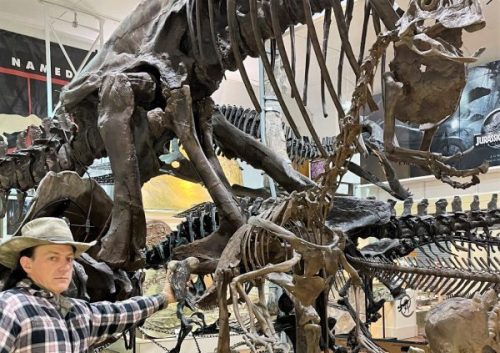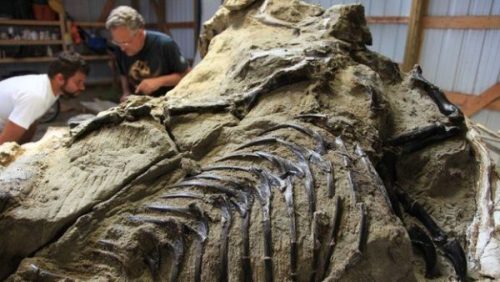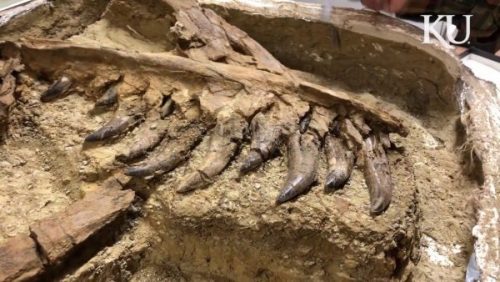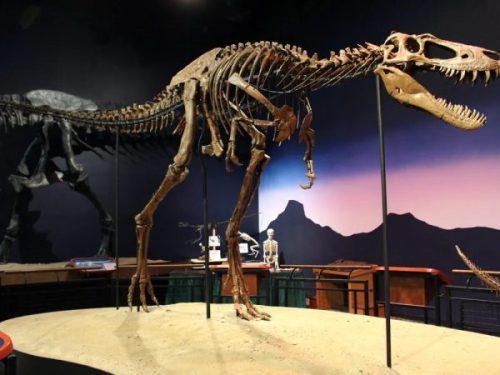
The world of paleontology has always been a realm of intrigue and discovery, where each fossil unearthed unveils a chapter of our planet’s ancient history. Among the many captivating creatures that have graced our Earth over millions of years, the Tyrannosaurus rex, with its immense size and formidable presence, reigns as one of the most iconic.
However, nestled within the annals of paleontological history, a smaller, enigmatic relative of the T. rex has captured the imagination of scientists and dinosaur enthusiasts alike: the Nanotyrannus. This pint-sized predator has piqued curiosity for decades, inspiring debates, questions, and further exploration into the past. In this article, we will delve into the intriguing world of Nanotyrannus and explore the enigma of North America’s tiny tyrant.
The Nanotyrannus Enigma
Nanotyrannus, which means “dwarf tyrant,” is a name that has been attached to a handful of dinosaur fossils found in North America. These fossils share certain characteristics with the larger Tyrannosaurus rex but are significantly smaller in size, raising the question of whether they represent a distinct species or simply juvenile T. rex individuals.

The story of Nanotyrannus begins in the late 1940s when a fossilized skull was discovered in Montana, USA. This skull, labeled “MOR 008,” was initially identified as a juvenile T. rex due to its relatively diminutive size.
The idea of young T. rexes having different skull shapes compared to adults was not uncommon in paleontology. However, over the years, some experts began to challenge this notion, suggesting that MOR 008 could represent a separate, smaller species entirely.
The Nanotyrannus enigma deepened with the discovery of additional specimens in the 1980s and 1990s. These fossils, collectively known as the “Black Hills Institute Nanotyrannus specimens,” included more complete skeletons and provided a more detailed look at this diminutive dinosaur. These specimens seemed to display features that set them apart from juvenile T. rex specimens.
The Debate
The debate surrounding Nanotyrannus primarily revolves around whether it is a unique species or merely a juvenile form of the T. rex. To address this question, paleontologists have undertaken extensive research and analysis of these fossils, employing a variety of scientific techniques and methodologies.
One key point of contention is the size of the Nanotyrannus specimens. While they are undoubtedly smaller than typical adult T. rex specimens, their size falls within the range of what would be expected for juvenile T.
rex individuals. Furthermore, features such as the number and arrangement of teeth, the shape of the skull, and the size of the arms have been cited as potential evidence for a distinct species. Some researchers argue that these differences are significant enough to warrant separate species status.

Conversely, opponents of the Nanotyrannus hypothesis argue that the variations observed in these fossils could be attributed to individual variation within the T. rex species. They suggest that factors such as age, sex, or environmental conditions might explain the observed differences without necessitating the recognition of a new species.
The Scientific Approach
In the quest to unlock the Nanotyrannus enigma, paleontologists have adopted various scientific methods to shed light on the true nature of these fossils.
Morphological Analysis: Researchers have conducted detailed morphological studies, comparing the physical characteristics of Nanotyrannus specimens to those of juvenile and adult T. rex specimens. By meticulously examining differences in bone structure, cranial features, and tooth arrangement, they aim to determine whether the discrepancies are significant enough to classify Nanotyrannus as a separate species.
Isotopic Analysis: Isotopic studies of the teeth and bones of Nanotyrannus have been conducted to gain insights into its diet, growth patterns, and ecological niche. Comparing these results to known data about T. rex can provide clues about the relationship between the two.
CT Scanning and 3D Modeling: Advanced imaging techniques, such as CT scanning and 3D modeling, have allowed scientists to create detailed digital reconstructions of Nanotyrannus specimens. These digital models enable a more in-depth analysis of anatomical features, facilitating comparisons and classifications.
Genomic Analysis: While challenging, some scientists have attempted to extract genetic material from the fossils for genomic analysis. This cutting-edge approach may provide insights into the evolutionary relationship between Nanotyrannus and T. rex.
The Ongoing Quest
The debate over Nanotyrannus continues to be a lively topic of discussion within the paleontological community. While some researchers argue for its classification as a distinct species, others remain skeptical, believing that more evidence is needed to definitively support this claim.
The quest to unlock the Nanotyrannus enigma serves as a testament to the dynamic and evolving nature of science. As new discoveries are made and innovative techniques are developed, our understanding of prehistoric creatures like Nanotyrannus is subject to change. With each step forward, we inch closer to resolving the mystery of North America’s tiny tyrant.

In the end, whether Nanotyrannus is recognized as a distinct species or a junior T. rex, its existence adds richness and complexity to the tapestry of Earth’s prehistoric past. It reminds us that the story of life on our planet is full of surprises, waiting to be uncovered and shared with the world.
Unlocking the Nanotyrannus enigma may take time, but the journey itself is a testament to the boundless curiosity and determination of scientists who seek to unravel the mysteries of our planet’s ancient history. As we delve deeper into the past, we come to appreciate the intricacies of life on Earth, from the mightiest giants to the most enigmatic small tyrants.






